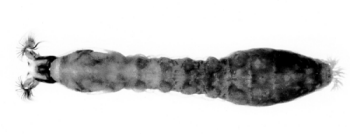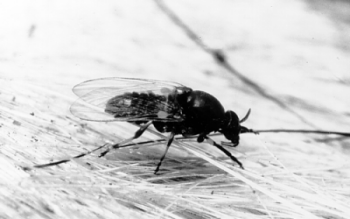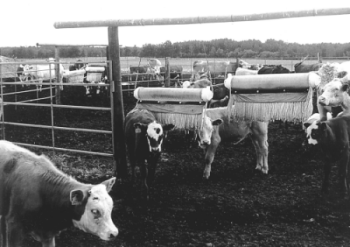| | Life cycle | Human protection | Livestock protection | Larval control | Adult control
Black flies, which number about 100 species in Canada, occur in varying abundance in all parts of the country. Adult females feed on blood, causing irritation and discomfort to humans, domestic and wild mammals and birds. Apart from the annoyance and discomfort, black flies cause economic losses through reduced beef and milk production, reduced efficiency of agricultural and industrial workers, and spread of diseases. In Canada, black flies transmit blood-borne parasites to turkeys, geese, and ducks. Naive cattle (not previously exposed) have died following a heavy attack by black flies in Alberta.
Life Cycle
Black flies have four stages of development: egg, larva (Figure 1), pupa, and adult (Figure 2). The eggs, larvae, and pupae are confined to rivers and streams. Once the eggs hatch the larvae drift and attach themselves to rocks and vegetation in the swiftest flowing water. The larvae feed by filtering nutrients from the water and, at summer temperatures, grow to about 6-10 mm. They pupate within two or three weeks.
After a few days in the pupal stage the adults escape from the pupa and float to the surface in an air bubble. Both adult male and female black flies feed on nectar and plant juices to meet their energy requirements. Mating occurs soon after emergence. Females of biting species then seek blood, which they require to produce eggs.

Figure 1. Black fly larva

Figure 2. Black fly adult
Human Protection
Harassment of people by black flies can be reduced by wearing suitable clothing, using repellents, or avoiding outdoor activities during periods of peak black fly activity. Black fly attacks are usually more severe in the morning, late afternoon, and early evening or when storm clouds are present. They are also more severe in wooded areas than in open areas.
Light-colored clothing is least attractive to blood-seeking females. Loose-fitting garments with zippers, fastened shirt sleeves, and pant legs tucked into socks or boots prevent black flies from crawling into the spaces between the clothing and the body. Head nets made of fine-mesh material can protect the head and neck.
Repellents, applied thinly and evenly, give good protection from black flies. Commercial repellents contain ingredients such as deet (N,N-diethyl-m-toluamide), 6-12 (2-ethyl-1, 3 hexanediol), citronyl and dimethyl phthalate. Exercise care when applying repellents to keep them out of eyes, mouth and nose. Repellents applied to clothing have a long-lasting effect. Jackets impregnated with repellents are available commercially. Because repellents may be toxic to animals, humans, birds and fish, always read the instructions on the container before using repellents.
Livestock Protection
Livestock can be protected from black fly attack by raising animals as far away as possible from black fly breeding grounds; by providing shelters so animals can enter and avoid attack during periods of intense activity; by treating animals with insecticides or repellents; and by implementing a larviciding program.
Cattle
Shelters, that provide dark conditions into which black flies will not fly are effective in providing cattle with relief from attack. Structures consisting of three solid walls and a roof are usually adequate. A shelter 6 m wide, 12 m deep (front to back), and 2.5 m high with two solid sides, one end wall, and a roof proved to be adequate for 20 mature cattle. Cattle quickly learn to use the shelters. Self-application devices for repellents and insecticides can be installed to treat cattle as the enter or leave the shelter.
Insecticide treatments must cover most of the animal's body to be effective. Only use repellents and insecticides specifically recommended for black flies and follow the label instructions carefully. Restrictions on use before slaughter or freshening must be followed.
An electrostatic sprayer allows efficient application of repellents or insecticides to cattle under pasture conditions. The insecticide or repellent solution is dispersed as charged droplets that are attracted to the hair of the animals. The advantages of this sprayer are that the animals need not be restrained or penned to achieve total body coverage, small amounts of spray solution are required, and little time is needed to treat the animals.
Backrubbers (Figure 3), charged with insecticides or repellents provide protection from black flies with minimum handling of animals. Free-use applicators can be placed in pasture or yard locations where animals have convenient access to them whenever they want to use them. Forced-use applicators are installed in entrances to fenced-in mineral or water sources and the animals receive a repellent or insecticide treatment every time they enter and leave the enclosure. This method of application is usually more effective that the free-use method.

Figure 3. Backrubber oiler
Horses
Shelters, similar to the ones described for cattle protection, can also provide horses with a refuge for temporary relief from black fly attack. Commercial repellents are available and should be used as directed on the label. Application of white petroleum jelly to the inside of horses' ears is effective in reducing attack by species that bite the ears.
Poultry
Poultry can be protected from black fly attack by keeping them indoors during the evenings especially during periods of intense black fly activity.
Sheep and swine
Sheep and swine can be offered temporary relief from black fly attack by having access to shelters as described for cattle.
Larval Control
Eradication of black flies over large areas is not feasible. However, focusing on larval breeding sites can provide good control of along sections of rivers and streams that can potentially produce outbreak populations. Water level manipulations or larvicide applications at the correct time of the life cycle will substantially reduce the populations. At known breeding sites, a carefully calculated concentration of larvicide injected into the water kills larvae and reduces black fly numbers.
A larval control program should aim to kill the greatest number of larvae possible with a single application of larvicide. Once the larval habitat of pest species is determined, cost-effective control can be implemented when high numbers of larvae accumulate.
Small-scale larvicide programs involve applications from a boat, of either undiluted or diluted insecticide. A variety of techniques including tank, barrels, backpack sprayers, or a watering can, may be used depending on the amount required and the type of stream.
Calculations for larviciding
To determine the amount of insecticide required, the stream discharge and dosage required must be known. Amount required = discharge x application rate. Discharge is calculated by determining the width and average depth of the stream in metres, at a point upstream from the area to be treated. Measure the velocity of the stream, in metres per second, at several points using a hydrographic flowmeter, or by timing a floating object over a measured distance not less that 5 m. The object, such as an apple or orange, should be heavy enough that it is not affected by the wind. The average velocity, using the latter method, is about two-thirds of the measured surface
velocity. The stream discharge then is calculated:
Width (m) x average depth (m) x velocity (m/s) = discharge (m3/s)
The biological larvicide Bacillus thuringiensis israelensis (Bti) is used at a variety of application rates, depending on concentration of the formulation and dosage desired. The label gives formulation concentration and recommended doses.
Application
Apply the insecticide across the width of stream or river for the time specified by the application rate. The point of application must be far enough upstream from the larval habitat so that the insecticide is properly dispersed in the water passing over the infested area. It is important to know what the effective "carry" (to maximum distance at which 80 per cent or more of the larvae are killed). The carry distance will determine the number of locations needed to cover the treatment area effectively. Carry is determined 24-48 h after passage of the Bti suspension. The suspension will travel at about the same velocity as the river. Care should be taken because river velocity can vary a great deal over 5 km. If a first treatment does not significantly reduce the larval numbers, further treatments may be required. In addition, black fly species that have more that one generation per year will require repeated treatments throughout the year.
Consult personnel with experience in monitoring larval populations when a larvicide program is being considered, because they know the techniques needed to develop an effective program.
A permit from Alberta Environmental Protection is required when insecticides are applied to flowing water.
Adult control
Temporary relief from adult flies can be obtained from proper use of spatial sprays. A spatial spray is a fine spray, mist or aerosol, consisting of very small droplets of insecticide solution that are dispersed by movements of air. The droplets contact adult black flies that are in flight or at rest. However, because spatial sprays produce no effective residual deposits of insecticides, the relief is temporary and treatments may have to be repeated daily while adults are a problem.
Spraying of vegetation in farm yards, with insecticides that have residual properties will provide temporary relief from black fly attack. The insecticide may be applied as a fine mist or a light spray. A compressed-air sprayer fitted with a fine-spray nozzle or an aerosol generator can disperse the adulticide sufficiently to reduce adult fly numbers temporarily in confined areas. Check provincial regulations before controlling adult black flies.
Application
When using a fogger (thermal aerosol generator), apply the insecticide just before sunset or just before sunrise, when black fly adults are most active. Wind speeds of less than 10 km/h are ideal for ground dispersal. The generator should be move in parallel lines, at 5 to 6 km/h, working upwind at intervals of 200-350 m.
Table 1. Larvicide
Product | Trade name | Preparation and application | Precaution |
Bacillus
thuringiensis
israelensis | Vectobac,Teknar,
Bactimos | Application to infected streams:
Amount required = discharge x application rate.
May require a licenced applicator. Check with Alberta
Environmental protection for larviciding permits. | Do not apply to treated,
finished drinking water. |
Note: Always follow the manufacturer's label instructions for proper mixing and application.
Table 2. Adulticides
Product | Trade name | Preparation and application | Precaution |
| Malathion 50% EC |  | Backrubber application to beef and dairy cattle:
Mix 1 L of 50% Malathion and 24 L of fuel or diesel oil in a backrubbing device. Devices must be continuously available and serviced to ensure optimum use and operation. | Do not apply to animals under one month of age. |
| Permethrin | Ectiban | 0.5% backrubber treatment: beef and non-lactating dairy cattle: Mix 250 mL 10% EC or 100 mL 25% EC/5 L lightweight oil. Devices must be continuously available and serviced to ensure optimum use and operation. DO NOT apply to animals under one month of age. Discontinue treatment 30 days before slaughter.
0.05% spray treatment: beef and non-lactating dairy cattle. Mix 200mL of 25% EC/100 L of water. Apply 1-2 L/animal over the whole body. Repeat application if necessary after eight days. | Leave a seven day interval between last spray and avoid contact with skin and eyes.
Do not apply within 30 days of freshening. |
Note: Always follow the manufacturer's label instruction for proper mixing and application.
Table 3. Fogs and Sprays
Product | Trade name | Preparation and application | Precaution |
| Dichlorvos | Riddex, VapoFog | Thermal Fog: Apply as a dense fog close to the ground to black fly resting areas. Prepare fogging mixture as directed on the label. | Do not contaminate feed or food products. |
| Malathion | m-50, Vanquish, Riddex, Cythion | Ground Fog, aerosol or space spray: Mix 1.1 L of 50% malathion concentrate in 10L of water or oil and apply mixture at a rate of 4 L/ac (10L/ha). Fog in early morning. Repeat as necessary. | Do not contaminate feed or food products. |
Note: Always follow the manufacturer's label instruction for proper mixing and application.
Prepared by:
Expert Committee on Arthropod Pests of Animals 1993
For more information, contact:
Dr. B.A. Khan
Alberta Agriculture
Source: Agdex 651-6. |
|